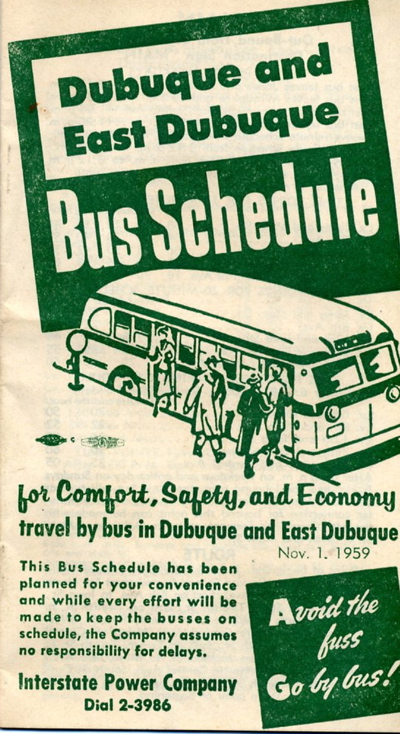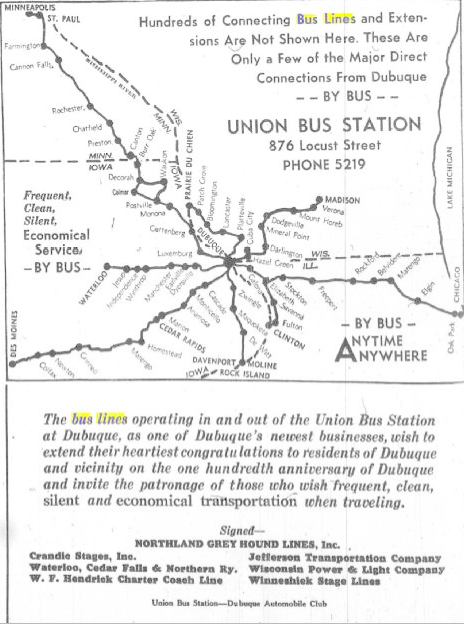Encyclopedia Dubuque
"Encyclopedia Dubuque is the online authority for all things Dubuque, written by the people who know the city best.”
Marshall Cohen—researcher and producer, CNN
Affiliated with the Local History Network of the State Historical Society of Iowa, and the Iowa Museum Association.
INTERCITY BUS HISTORY
INTERCITY BUS HISTORY. Inter-city bus transportation by 1923 was becoming a highly competitive and financially rewarding business. In that year proponents of the Mississippi Valley Scenic Highway contacted business leaders in Dubuque seeking their support and suggesting, among many reasons, that a north-south bus line would be nearly assured. (1) A line between Dubuque and Gratiot, Wisconsin was announced in March, 1923. The same month, however,, the Platteville-Dubuque bus lines declared that unless they were granted the same toll concessions as granted to the Dubuque-East Dubuque carrier, they would have to discontinue the business. (2) Records kept by the Chamber of Commerce showed that from April to October, 1923 the bus station at the Chamber of Commerce had served 6,952 persons. (3)
By April, 1924 a bus line from Galena to Dubuque was expected with another line planned for May 1st. (4) The Marshalltown Times-Republican in 1925 quoted the secretary of the DUBUQUE COMMERCIAL CLUB that bus lines were bringing in not less than 1,200 "cash customers" monthly to Dubuque. (5) In December, 1925 each of the seven bus lines operating from the bus station in the basement of the Chamber of Commerce building was bringing in capacity loads daily. The station was so busy that the city was bringing in park benches for the crowds of people. A parcel wrapping service "avoiding confusion in the stores" and a parcel mailing service were additional services offered in the station. (6)
Elliot B. Laude and Donald Fraser HUNTOON, local businessmen who operated Laude & Huntoon, traveled to Independence in May, 1926 to question members of the Greater Independence Booster Club about the possibility of beginning a bus line between Dubuque and Independence. The company was already operating a bus line between Dubuque and Monticello. The approval of the state railway commission was necessary for the line to start. (7) Bus lines between Maquoketa and Dubuque, Madison and Dubuque were in place by 1926. (8) Cedar Rapids was added in 1927 the same year the Royal Rapid Transit Company of Madison offered Dubuque, Rockford, Chicago and Dubuque, Dodgeville, Madison routes. In 1928 a bus line between Dubuque and Prairie du Chien was in operation and the Platteville line was making two trips daily between Platteville and Dubuque. (9)
In 1927 the authority to operate the bus route between Dubuque and Waterloo was awarded by the Iowa Commerce Commission to the Central Transportation Company, a subsidiary of the Illinois Central Railroad. In awarding the contract, consideration was given to the belief the railroad would suffer loss of some of its business if the bus line were operated by another company. The bus service carrying freight with one-round trip daily would replace two present trains of the railroad which had been losing money. The trains could be used if highway conditions prevented the use of buses. The daily bus would leave the Illinois Central Station at 7:45 a.m. and stop at all main hotels before leaving the city. It would arrive in Waterloo at 11:55 a.m. The bus would leave Waterloo at 4:00 p.m. and arrive in Dubuque at 8:15 p.m. (10)
In 1926 the bus station at the Chamber of Commerce building extended its hours from 6:15 a.m. until 9:15 p.m. with a matron in charge of the COMMUNITY REST ROOMS throughout the day. It was also decided that patrons of the bus lines could check their parcels free of charge. (11)
Offices of the Royal Rapid Transportation Company moved from the HOTEL JULIEN in May, 1929 to the bus station in the Chamber of Commerce building. Offices of the DUBUQUE AUTOMOBILE CLUB were also moved to the bus station and all the bus offices were merged with the Automobile Club. It was announced that representatives of the freight bus lines would be invited to make their headquarters at the Automobile Club or at the union bus station on Iowa Street between Second and Third STREETS. (12)
Schedules and rates were the topics of discussion at a meeting held on January 13, 1933 between Dubuque business leaders and representatives of bus line operators. One representative noted that in addition to franchise and operating expenses, a bus company had to carry public liability insurance, purchase license plates for each bus, and pay gasoline and tonnage tax. The average cost of bus transportation was estimated at 14-15 cents a mile per customer. Plans were made for organizing a local highway and bus users' commission to fight high motor vehicle and gasoline taxes. (13) In 1934 Dubuque had seven bus lines operating 26 buses in or out of the city daily. (14) In 1935 this had been reduced to six: Jefferson Transportation Company, to and from Minneapolis; Northland Greyhound Line, operating between Dubuque, Milwaukee and Chicago; Black and White Line, operating between Dubuque and Waterloo; Interstate Transit Line, between Dubuque and Cedar Rapids and Davenport, Winneshiek Stage Line, between Dubuque and Platteville and Prairie du Chien; and the Orange Line operating between Dubuque and Madison. (15)
The announcement was made in October, 1939 that the new union bus station would be constructed on the northwest corner of Third and Main streets. C. E. Rhoades, manager of the Dubuque Automobile Club and the bus station, had awaited word that the Union Pacific Railroad Company, operators of the Interstate Transit Lines, had signed a ten-year lease with the club for the use of a station at that location. A similar lease had been signed by the Northland Greyhound Lines. The new station, which would also house the headquarters of the Automobile Club, would have one story and a basement each with 2,100 square feet of space. The new building would have twice the space for a waiting room and would be able to accommodate three buses at one time. (16) In 1983 the Union Bus Station was located at 485 Central and was the agent for Greyhound Bus Lines, Iowa Coaches, Inc., River Trails Transit Lines Inc., and Scenic Trails Inc. The station was open from 7:00 a.m. to 7:45 p.m. Monday through Friday; and 7:00 a.m. to 12:45 p.m. and 4:00 p.m. to 7:45 p.m. weekends and holidays. (17)
In 1988 Greyhound Lines, expanded its "Rural Connection" program in Iowa. Greyhound contacted the Regional Transit Authority of Dubuque, Jackson, and Delaware counties about beginning between the smaller towns and the union bus station in Dubuque. RTA at the tine provided transportation to rural residents with private, volunteer-driven cars and agency mini-buses. The program was aided by a $100,000 federal grant to two transportation organizations--Rural America and the National Association for Transportation Alternatives which helped Greyhound expand. (18)
In August 2015 the Dubuque Intermodal Transportation Facility began operations at 950 Elm. The city paid approximately half of the $16 million cost with state and federal funding covering the rest. The facility's goal was to centralize all modes of transportation in one hub and reduce the number of cars being used especially during peak hours. The facility was not designed to serve passenger trains. At a future date if passenger train service came to Dubuque the terminal would be constructed in the Port of Dubuque. (19)
---
Source:
1. "Seek Dubuque's MRSH Attitude," Dubuque Telegraph-Herald, March 27, 1923, p. 7
2. "Ask Concessions in Bridge Tolls," Dubuque Telegraph-Herald, March 8, 1923, p. 3
3. "Chamber Plans Great Program to Aid Dubuque," Telegraph-Herald, October 28, 1923, p. 1
4. "More Bus Lines to be Operated," Dubuque Telegraph-Herald, April 20, 1924, p. 11
5. "Current Comment," Telegraph-Herald, February 25, 1925, p. 6
6. "Business Season for Bus Station," Telegraph-Herald, December 14, 1925, p. 4
7. "May Start Bus Line to Independence," Dubuque Telegraph-Herald, May 13, 1926, p. 9
8. "Bus Station to be Open Longer," Dubuque Telegraph-Herald, May 14, 1926, p. 19
9. "Wisconsin Bus Lines Operating," Telegraph-Herald and Times-Journal, April 22, 1928, p. 9
10. "Bus Station to be Open Longer..."
11. "Bus Franchise to I.C. Subsidiary," Telegraph-Herald and Times-Journal, April 5, 1929, p. 15
12. "Royal Rapid Line to Move Offices," Telegraph-Herald and Times Journal, May 10, 1929, p. 41
13. "Business Men Meet with Bus Line Operators," Telegraph-Herald and Times-Journal, January 13, 1933, p. 11
14. "Dubuque-A Center of Motor Transportation," Telegraph-Herald and Times-Journal, July 1, 1934, p. 7
15. "Four Railroads Serve Dubuque and Territory," Telegraph-Herald and Times-Journal, January 13, 1935, p. 35
16. "Work to Start on Bus Station," The Telegraph-Herald, October 18, 1939, p. 1
17. "Getting Around," Telegraph Herald, July 20, 1983, p. 19
18. Kitchen, Rich. "Greyhound Expanding 'Rural Connection,' " Telegraph Herald, July 17, 1988, p. 6
19. Wiedemann, Katie. "City Buses Begin Service at Dubuque's Intermodal Transportation Facility," KCRG.com Online: https://web.archive.org/web/20150929041802/http://www.kcrg.com/subject/news/city-buses-begin-service-at-dubuques-intermodal-transportation-facility-20150817



